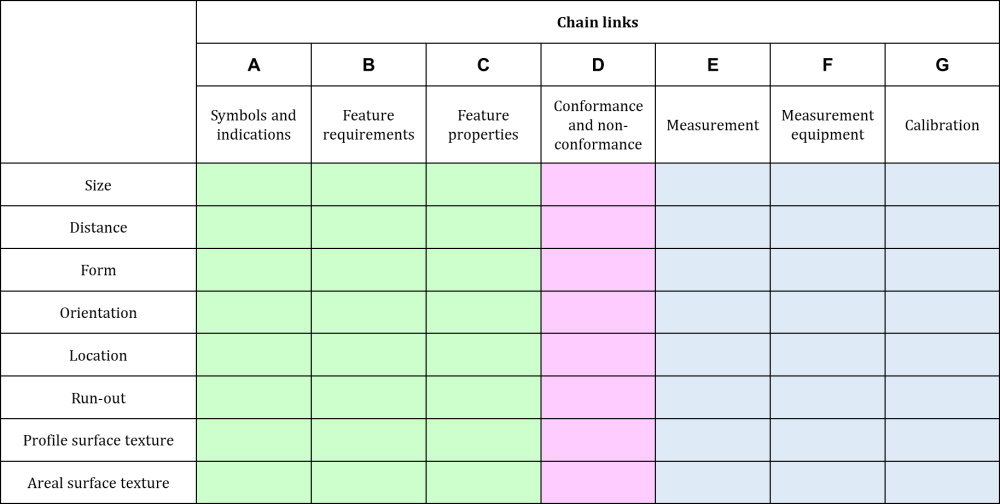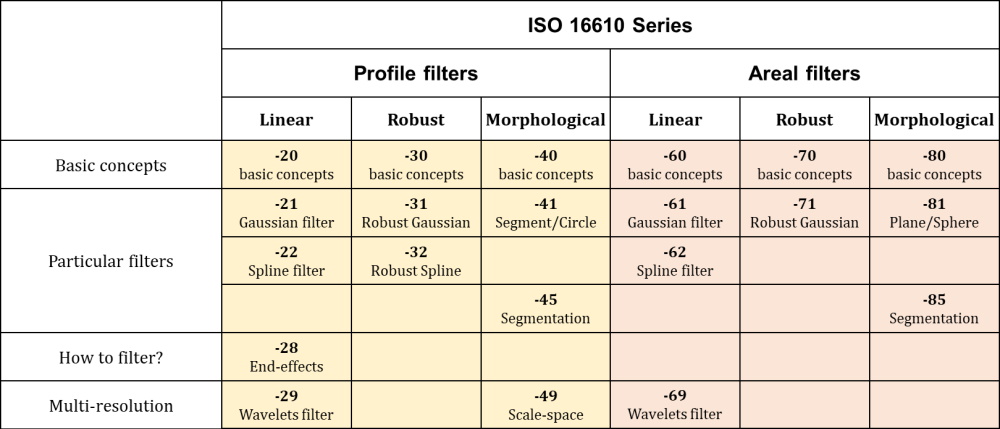What is the GPS matrix?
Users of GPS (Geometrical Product Specification) standards are aware of the GPS matrix which is a convenient way of classifying standards in the various chain links of the specification-verification chain. But are you sure to know how to use it?
A matrix to rule them all
The initial GPS matrix with six columns, defined in ISO 14638:1996, was updated in 2015 with the addition of a seventh column (see Table 1)
The first three columns, A to C, refer to the specification prepared by the design studio and written in the technical product documentation. This should describe all the necessary details to allow the workpiece to be manufactured by a third party and yet conform to the specification. The last three columns, E to G, refer to the verification carried out by the metrology lab, to check that the workpiece has the required characteristics. Middle column D, the famous new seventh column, refers to conformance procedures to ensure that the actual workpiece complies to the specification.
The lines of the matrix correspond to categories of characteristics used in dimensional metrology as well as in surface metrology. Each standard developed by ISO TC213 contains an annex with the GPS matrix stating which chain links are concerned by the document.

Table 1. The GPS matrix, as updated in the 2015 edition of ISO 14638
Chain links for surface texture
Surface texture standards cover the last two lines. Some old standards sometimes belong to more than one column. In principle, modern standards should be limited to a single column, covering possibly several lines.
- Column A contains standards describing how to write specification symbols on technical drawings, such as in ISO 1302, ISO 21920-1 or ISO 25178-1.
- Column B contains very important standards defining parameters such as ISO 4287, ISO 13565-2, ISO 13565-3, ISO 21920-2 or ISO 25178-2.
- Column C contains standards explaining how to configure the parameters; these are called specification operators. Standards such as ISO 4288, ISO 21920-3 or ISO 25178-3 belong to this column, and also standards defining filters such as the ones defined in the ISO 16610 series. Note that the two recent standards, ISO 21920 and ISO 25178 follow in their suffix the numbering of the chain link (-1 for symbols, -2 for parameters and -3 for specification operators, although the matrix now uses letters, A, B and C).
- Column F (or the 6th column) contains ISO 3274, ISO 25178-6, ISO 25178-600 and the ISO 25178-6xx series describing the instrument techniques.
- Column G is about calibration and contains ISO 25178-70, ISO 25178-71, ISO 25178-72, ISO 25178-73, ISO 25178-700 and ISO 12179.
- Column E is quite empty for surface texture. It is supposed to discuss how to calculate uncertainties, how to compare results to tolerance limits.
Column D mainly contains the ISO 14253-x series on decision rules for verifying conformity. This series is quite global and can be applied equally on dimensional or surface texture.
An interesting example is ISO 12085, the old motifs method, which covers several links of the GPS matrix. It defines the R&W parameters (column B) and the segmentation and its limits (column C) and gives recommendations on how to measure the profiles and how to choose spacing (column F). This standard today would be split into several parts, each covering a single column of the GPS matrix.
On top of all these standards are fundamental standards that apply in all cases and to all chain links. For example, ISO 1 on reference temperature is a fundamental standard. The ISO 14638, that defines the GPS matrix, is itself a fundamental standard. This scheme may evolve again in a few years as TC213 recently started internal work to reorganize all existing GPS standards in a more hierarchical scheme. The GPS matrix may see a reshuffle of the standards in a few years.
Other matrices
There are also other useful matrices in GPS standards. For example, the Filtration matrix from ISO 16610 (see Table 2). As new standards are in preparation within this series, the matrix will likely be extended, with new columns (50 and 90) and also, in the future, it will host a new type of element with the triangle mesh data. But that is for later...
The areal standard ISO 25178, also has its own matrix, with many documents relating to instruments and calibration (parts 6xx, 7x, 7xx...).

Table 1. The filtration matrix from ISO 16610
Additional resources
Learn more about surface metrology with our video courses: Video courses on surface metrology.